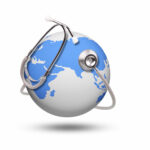Armenia celebrates Motherhood and Beauty Day every April 7 to appreciate women and their role in society. Did you know Armenia was the world’s first official Christian state? Motherhood and Beauty Day is a national holiday in Armenia, celebrated on the same day as the Feast of the Annunciation. In Armenia, it’s customary to present flowers or twigs with fresh sprouts to mothers, grandmothers, sisters, and other female relatives. Motherhood is celebrated on April 7, but Armenians also celebrate all women on March 8 on Women’s Day.
History of Motherhood and Beauty Day
The Armenian people’s origins can be traced back to 1500 to 1200 B.C. However, the history of the state of Armenia began during the 6th century B.C., when it became a geographical entity under the Orontid Empire. In 190 B.C., the Armenian kingdom became a sovereign nation under King Artaxias I. During the reign of Tigranes the Great, between 95 and 66 B.C., Armenia became the most powerful kingdom east of the Roman Republic. Later, Armenia was ruled by the Arsacid dynasty, a branch of the Parthian Empire.
The Sassanid Persians took control of the kingdom in 25 and held it until the Romans returned in 287. For centuries, Armenia was passed from one nation to another, including the Byzantines and the Iranian Sallarid dynasty. In 301, Armenia became the first nation to adopt Christianity as a state religion. The Armenian Church later became independent of the Catholic and the Eastern Orthodox churches. Following the Russo-Persian War (1826 — 1828), Eastern Armenia was annexed by Russia and became known as the Province of Yerevan. During this period, Armenians were treated as second-class citizens, with no access to education and administrative opportunities.
The Ottoman Empire started a systematic killing of Armenians between 1915 and 1916. Nearly 1.5 million ethnic Armenians were killed during the Armenian genocide. Following the fall of the Ottoman and Russian empires, a portion of Armenia gained independence. In 1917, Armenia attempted to form a federal state with other Caucasus provinces, but the republic collapsed in April 1918. Armenia was established as the Armenian Soviet Socialist Republic, a constituent republic of the Soviet Union, in 1936. On August 23, 1990, Armenia declared its independence from the Soviet Union. However, it was not recognized as an independent nation until the Soviet Union collapsed on December 25, 1991.
Motherhood and Beauty Day timeline
Armenia becomes the first nation to adopt Christianity as a state religion.
The Ottoman Empire systemically kills millions of ethnic Armenians.
Armenia becomes a constituent republic of the Soviet Union.
Armenia declares independence from the Soviet Union.
Motherhood and Beauty Day FAQs
Who should be celebrated on Motherhood and Beauty Day?
Despite its name, Motherhood and Beauty Day is intended to honor all women. It’s also a day to appreciate women’s contributions to their families and society.
What is Armenia famous for?
Armenia is well-known for having one of the world’s oldest churches and monasteries, as well as its unique culture, cuisine, and history.
Are men and women equal in Armenia?
According to the Armenian Constitution, men and women have equal rights in every aspect of life, including politics, work, and family.
Motherhood and Beauty Day Activities
Give flowers to women in your life
Women are traditionally given flowers on Motherhood and Beauty Day. Get all the women in your life their favorite flowers from your local florist.
Support gender equality
While the Armenian constitution guarantees equal rights to men and women, gender equality remains a major issue in the country. Motherhood and Beauty Day can promote gender equality by hosting a public forum, encouraging your politicians to pass favorable laws for women, or volunteering for a women's empowerment program.
Participate in Motherhood and Beauty Day’s event
On Motherhood and Beauty Day, as on International Women’s Day, various organizations and businesses organize events and programs to promote women's rights and highlight women’s achievements. If you are interested, you can take part in one of these events. Check online, on Google, or on social media platforms for events near you.
5 Interesting Facts About Armenia
More Armenians live abroad
Compared to the current Armenian population of around three million, over five million Armenians live abroad.
One of the world’s oldest capitals
Yerevan, the capital of Armenia, is one of the oldest inhabited cities in the world.
It has a dish on the UNESCO list
Lavash, an Armenian bread, is on UNESCO's list of Intangible Cultural Heritage.
It has three UNESCO World Heritage Sites
The monasteries of Haghpat and Sanahin, the cathedral and churches of Echmiatsin, the archaeological site of Zvartnots, and the monastery of Geghard and the Upper Azat Valley are all UNESCO World Heritage Sites in Armenia.
Mount Ararat is their national symbol
The mount is considered sacred by Armenians but it is actually located in Turkey.
Why We Love Motherhood and Beauty Day
It celebrates women
While women's rights remain a source of contention in Armenia, Motherhood and Beauty Day — like International Women’s Day — raises issues of gender equality in the country, which can be addressed. It also highlights the various achievements of women and their importance to the socio-economic development of Armenia.
It celebrates motherhood
Motherhood is highly valued in Armenia and has long served as a symbol of Armenian identity. The image of the mother has been invoked at critical points in the country’s history to drive support for an idea, reform, struggle, or movement. Historical figures such as the Virgin Mary, the mother of Jesus, are strongly revered and celebrated in the country.
It promotes family unity
Motherhood and Beauty Day brings people together to celebrate the women and mothers in their lives. On this day, sons and fathers send messages of affection and appreciation to the women in their lives, as well as settle any long-standing disputes.
Motherhood and Beauty Day dates
| Year | Date | Day |
|---|---|---|
| 2026 | April 7 | Tuesday |
| 2027 | April 7 | Wednesday |
| 2028 | April 7 | Friday |
| 2029 | April 7 | Saturday |
| 2030 | April 7 | Sunday |






















